Michael Fumento
Factual · Powerful · Original · Iconoclastic
Return to Ramadi
January 01, 2006 · Michael Fumento · The Weekly Standard · Military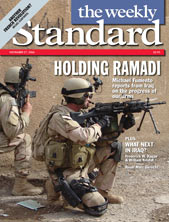 Ramadi, Iraq
Ramadi, Iraq
Operation Phantom Fury, the U.S. assault on Fallujah in Iraq’s Al Anbar Province in November 2004, is widely perceived as the greatest coalition
victory against Iraq’s insurgent and terrorist forces. It did indeed end enemy
control over the city. But civilian casualties were high because of the
massive use of firepower. About a fourth of the city’s homes were destroyed
and another fourth damaged. And while many of the enemy died, the advance
notice of the attack plus the ability to escape across the Tigris and
Euphrates rivers in small boats meant that most of the fighters killed were
probably seeking martyrdom. The rest simply scattered like rats. Most of those
rebuilt their nests 30 miles west of Fallujah and 30 miles closer to Syria, in
Anbar’s capital, Ramadi.
Ramadi actually has many advantages over Fallujah for the enemy. With about 400,000 residents, it provides almost twice the population to hide among. Fallujah has a significant Shiite population; Ramadi is almost purely Sunni. And Ramadi has shorter supply lines to foreign terrorists, equipment, and cash from Syria and Jordan to the west. Once the foreign terrorists reach Ramadi, they can use it as a way station to other Sunni areas throughout the country or simply stop there and take up residence.
Last spring I visited Fallujah and the surrounding area for the second time and Ramadi for the first time, writing articles on each in these pages. I noted that Fallujah had clearly become more violent, but that this wasn’t particularly alarming considering that about half of the population had returned and with it some of the enemy who could hide among them. Further, security in parts of the city was being turned over to the Iraqi Army (IA) and Iraqi Police (IP). Obviously this was a positive development, but when the IA or IP take over an area, the bad guys fiercely try to demoralize them and drive them out.
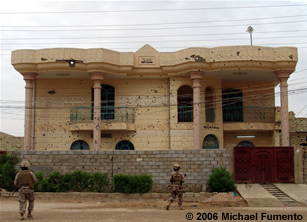
Battle-damaged house in Fallujah
Ramadi was a different situation entirely. AP’s Todd Pitman, with whom I was
embedded, correctly noted that the "sheer scale of violence in Ramadi is astounding." And Pitman specializes in going to violent places. Leaving your base camp ("going outside the wire") during daytime practically guaranteed an attack. I went on two patrols and we got hit both times. The military says Ramadi "remains the most contentious city right now inside Iraq."
For this very reason, Ramadi is both a litmus test for the counterinsurgency effort in Iraq and a laboratory. If we can defeat the insurgent and terrorist forces here, there is no place we cannot defeat them. And from what I found, we are defeating them. It’s painfully slow, and our men there are still dying in inordinate numbers from a broad variety of attacks. But a multitude of factors, including tribal cooperation, the continual introduction of more Iraqi army and police, the beginning of public works projects, the building of more Forward Operating Bases (FOBs), the installation of more small operational posts (OPs), and plunking down company-sized Combat Operation Posts (COPs) smack in the middle of hostile territory are destroying both the size and the mobility of the enemy. This time the rats are dying in place.
Return to Ramadi
I arrived in Ramadi in early October. It was good to be back. Transportation to and from Iraq and within it is the hardest part of any embed; indeed it’s utterly nightmarish. After a wasted week, though, I’d made it and was breathing in that wonderful dust, which those who haven’t experienced it call "sand." It goes deep into your lungs, making you cough like Doc Holliday. Add water when the rains come and it produces a mud with the consistency of peanut butter. The heat was slightly above 100, but with virtually no humidity it was nothing to complain about.
I wanted to see if Ramadi had changed in the last half year, and this was a good time to do so because it was the holy month of Ramadan, a period of fasting and prayer for the devout, and for the enemy a time to show Allah just how willing he is to die – and to kill – for Him. I expected another worthless in-briefing at Camp Ramadi such as I’d gotten from the previous tenants, the 2/28 Pennsylvania National Guard. It consisted of a film of the unit’s grand history, and I was stunned that they would cut almost two days off my time in the city to arrange for me to watch it. Since then, 2/28 has departed and been replaced by the 1st Brigade Combat Team (1st BCT), whose commander, Col. Sean MacFarland, calls it "Ready First Combat Team." Happily, the briefing – provided by briefing officers Capt. Travis Patriquin and Col. Peter Lee – had nothing to do with the history of the unit and everything to do with Ramadi. [Regretfully, Capt. Patriquin was killed in an IED blast on Dec. 6. Killed with him was the PAO for al Anbar province, Marine Maj. Megan McClung.]
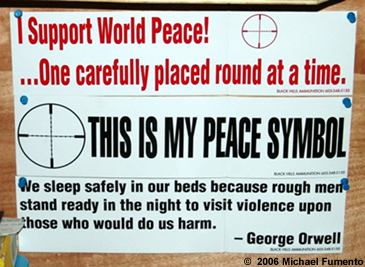
Desk of Cpt. Travis Patriquin at Camp Ramadi.
Shortly after my last trip, the situation had deteriorated to a point where there was much discussion – prompted largely by false Los Angeles Times articles from correspondents reporting from the remoteness and comfort of a Baghdad hotel and from Washington – of a Fallujah-style attack on Ramadi. But this was never in the cards, being neither desirable nor possible. Indeed, there wasn’t even an increase in troops, except during the short period of overlap in early June when 1st BCT had fully deployed and 2/28 hadn’t completely left. 1st BCT comprises much of the 1st Armored Division’s First Brigade, the 1-6th Infantry and 1 35th Armor. Other elements include Marines, engineers, part of the 101st Airborne Division (Air Assault), and part of the 2nd Brigade, 1st Armored Division. The Navy provides corpsmen (medics) and SEALs, while the Air Force also augments the force.
Within weeks, 1st BCT did launch an offensive, but it moved slowly and relied far less on artillery and air support than did the Fallujah assault. Mechanized troops pushed north into the suburbs, cutting off two major entrances to Ramadi for the first time during the war. The enemy was chased into areas already patrolled by U.S. soldiers who knew the lay of the land better than he did. This provided breathing room for the next step – building additional Forward Operating Bases and outposts in the badlands.
Patriquin and Lee described how coalition forces break down the "anti-Iraqi forces" – the forces opposing the elected government of Iraq – into four categories. First there are the unaffiliated foreign fighters. Second is al Qaeda in Iraq, comprising both local and foreign terrorists. Third are local resistance fighters who are generally disgruntled ex-Baathists trying to get back the good life. Fourth are organized criminals and smugglers who are just in it for the bucks. Al Qaeda in Iraq, though relatively small, "is a significant threat to area residents because of its use of suicide bombers," MacFarland said. Iraqis do not venerate suicide in the way some Muslim peoples do – or for that matter the way Japan did until quite recently. When al Qaeda came to town, said MacFarland, "they intimidated, through murder and other acts of violence, the people of Ramadi and forced them into their homes, away from their places of employment."
Said Patriquin: "With the local al Qaeda some are motivated by money and some by ideology. You’re not going to change them. You either force them out or you kill them." These fighters are commonly known as JTJ, short for Jama’at al-Tawhid wal-Jihad, a group that operated in the area before al Qaeda set up shop and has since merged with it. The foreigners come seeking martyrdom, and the only way of dealing with them is to fulfill their wish. Conversely, the criminals and smugglers can be shown it’s not worth their while to ply their trade. As for the local resistance, "they originally sought to expel foreign forces, but can be easily swayed and are responsible for most of red on red [enemy Iraqi versus enemy Iraqi] violence," according to Patriquin. "We had a sheikh [pronounced shake] north of the river who was trying to put his men into the IP [Iraqi Police], and he was killed. Then the killers kept his body for several days, an insult almost as great as the murder itself. It angered local tribes so much that it galvanized them against the AIF [anti-Iraqi forces] and in favor of the coalition."
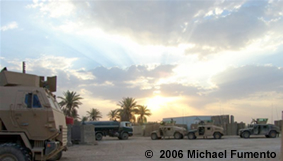
Sunrise in Ramadi
This led to the formation of a tribal council called the Sahawa Al Anbar, or Al Anbar Awakening, which "was designed to wake up the people of Anbar, who have been, for the last two years, allowing al Qaeda in Iraq and other elements to control the city and province of Al Anbar," Patriquin explained. "It started in August 2006 with 40 sheikhs representing 20 tribes from Al Anbar, and currently has over 50 sheikhs representing at least 25 tribes. There is currently tribal representation covering all of Al Anbar province, and they have provided more than 70 percent of our IP recruits in the last few months."
Even the Los Angeles Times – hardly pro-war or pro-Bush – in an October 5 article reported that local tribes are mad as hell about the insurgency and are not going to take it anymore. It observed that Abdul Jabber Hakkam, spokesman for a coalition of 11 tribes in Al Anbar, was saying locals were capturing and executing the anti-Iraqi forces on their own initiative. "People have done this with their own personal weapons," he said. "Now each house that hosts a terrorist, they will force all the residents of the house outside, so they’re on the streets." When that is done, he predicted, the insurgents will "have no one to keep them, and they will withdraw." Further, said Hakkam, "we are not just targeting al Qaeda, but terrorists in general, because people miss real stability and freedom." Importantly, he not only urged the locals to work with the tribes, but also said the tribes need to work closely with the government in Baghdad.
If you’re thinking this doesn’t reflect doomsaying media interpretations of Marine Col. Peter Devlin’s unreleased August intelligence report indicating there’s no functioning government in the Anbar, you’re right. The province has long been the domain of nomadic tribes. They have no EPA or Department of Education certainly. We’re not going to change that system soon and there’s little reason to do so. (Residents, for one thing, can simply establish a business overnight and taxes are low to nonexistent.) If they cooperate in the war effort, we’ve achieved our goal.
Turning Iraq over to the Iraqis
Probably the most important aspect of the plan to pacify Ramadi is the same as that for pacifying the country as a whole and drawing down U.S. troops – continuing to turn over more responsibilities and more geographic area to the Iraqi army and police. They’ll need armor and artillery support for the next several years and U.S. assets like air support and special ops for much longer. But in Ramadi, at least, the transfers seem to be working. During the fighting in June the Iraqi Army 1st Brigade, 7th Division (1/7) aided the Americans. They had arrived in Ramadi in late March. Now they’ve been joined by the Iraqi Army 1/1, the oldest Iraqi Army unit in the country and considered by many to be the best. With a total complement of several thousand soldiers, the two Iraqi Army battalions now have their own areas of responsibility in western Ramadi, though American heavy support is always nearby.
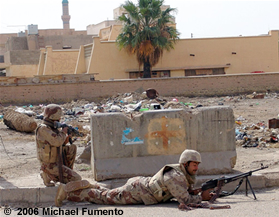
The size and quality of Iraqi Army forces in Ramadi continues to grow.
The Iraqi Army is better-armed than the last time I was in the Anbar. Back
then they lectured me on their need for 12.7 millimeter heavy machine guns called DUSHKAs, which the enemy has had all along, while I lectured them back on the need to kill the enemy rather than just defend themselves. In April, they were just taking delivery of armored Humvees; now these military vehicles are ubiquitous. Their equipment needs are still great; indeed, I was asked not to convey some details lest the enemy find out what they lack. But as the Iraqi soldiers earn the trust of the Americans, they’re getting vastly superior equipment, often when a unit rotates out and bequeaths it to them.
Nobody pretends the Iraqi Army will ever approach the U.S. military in its willingness and ability to fight; but in fairness, how many armies do? Further, it’s not as if the anti-Iraqi forces’ abilities will ever approach those of the Viet Cong. It’s considered remarkable when the enemy is so much as able to coordinate an attack, rather than just tossing a bunch of untrained men at an objective. The Iraqi Army units in Ramadi are capable of defending themselves and going on the attack with just a couple of American advisers. That’s real progress. Unfortunately, these units are almost exclusively Shiite at the enlisted level, with Sunni officers, which is not ideal for this Sunni region. But still they have the ability to speak with and relate to Iraqis of any sectarian persuasion better than Americans ever will.
There are now six Iraqi police stations in the city comprising several hundred police, and Ramadi has the fastest growing police recruitment program in Anbar. Ultimately, the city is slated to have a force of 4,000 police, but that’s a long way down the road. Elsewhere, the police have suffered from infiltration by the enemy, corruption, cowardice, and incompetence. But in Ramadi these don’t appear to have been problems. "The Iraqi Security Forces [both Iraqi Army and police] here in Ramadi are making measurable, great progress," MacFarland told me. "The fact that IPs are still flowing in, that IA units are now responsible for their own land, and that their integration with the locals has led to the discovery of multiple arms caches shows this." By contrast, he says, al Qaeda forces "stick out like a sore thumb" when they try to blend in. "Everybody knows who the terrorists are," he says. Moreover, it seems not even the most outspoken critic claims enemy strength is growing in Ramadi. Iraqi Army and police strength grows measurably by the month.
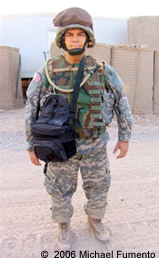
Fumento: "Hey, this isn’t San Tropez!"
In a move unique to Ramadi, 1st BCT bulldozed uninhabitable buildings near the government center just before I arrived. This area had repeatedly been used not just for sniping at Iraqi and American officials entering and exiting government buildings but to support full-scale attacks. "The government center was one of the most dangerous areas of Ramadi," Lee said. "The enemy would come in from their strongholds and seize buildings across the street and attack." The area now looks like Dresden after the firestorm, but engineers have started hauling away millions of tons of rubble. Once it’s cleared, the plan is to turn the land into a park. The project doesn’t just make sense from a military standpoint; it has a certain symbolism as well. A former killing ground for the anti-Iraqi forces will be turned over to the people of Ramadi for picnics and games.
Showing further aggressiveness, in July, 1st BCT, using the Iraqi Army as the spearhead, also seized what amounted to the anti-Iraqi forces’ only real fortress in Ramadi: Saddam Hospital. "It was basically an enemy base with facilities only for the enemy, command and control, and snipers," said Lee. One sniper killed Marines from a fourth-floor window at the hospital until he was counter-sniped. The facility was even used to launch mortar attacks. To the extent it was used as a hospital at all, it was only for the enemy. Abu Musab al Zarqawi allegedly received treatment there after he was wounded in May 2005.
The Americans had tried to build another hospital in the city, only to see it blown up when it was almost finished. The anti-Iraqi forces have no interest in trying to win the hearts and minds of Ramadi’s citizenry when they can accomplish their ends through threats, mutilation, and murder. Now the captured facility, renamed Ramadi General Hospital, has been turned over to civilians and is being upgraded from the 1950s era. It serves all the citizens of Ramadi; enemy suspects are treated and reported to authorities.
Almost all of these achievements are verifiable and would seem to indicate serious strides in retaking Ramadi. MacFarland says attacks have dropped from a daily average of about 20 to about 15, although there was a definite uptick during Ramadan as I will describe presently. "There is still certainly fighting, but the days of platoon-sized attacks are over," Patriquin says. "We welcomed it when they came at us with groups of 20 because it gave us a chance to kill them. But they just don’t have the capability of getting that many men together anymore." The commander of Ramadi’s Camp Corregidor would later tell me the same thing about one of his areas of operation, in southeastern Ramadi, known as the Mulaab. "You just don’t see groups of tens and twenties anymore," he said. "Now they tend to be onesies and twosies."
Among the overhead transparencies Patriquin and Lee showed were "before and now" images of Ramadi with translucent red oval overlays, which MacFarland calls "the blob chart," to show progress. "The areas that are red are those where we still consider AIF to have the control," I was told. That was about 25 percent of the city. "Over the time Ready First Combat Team has been here, we have squeezed this area into a significantly smaller portion of the city. The blobs’ reduction demonstrates the success we have had against the insurgency, creating a better security situation and limiting the areas where the AIF have freedom of movement." Lee added, "We own southern Ramadi; make no mistake. But in the north, there’s still a jungle out there."
Indeed, the coalition is now so confident of security in the area that it has begun $15 million in public works, including hauling the rubble near the government center, $1.4 million for a water treatment and power generation plant, and $6.5 million for Ramadi General. Applying the "broken windows" theory of crime, even trash disposal is a major part of the budget.
Back to Corregidor
One strong indicator that we’re making progress in Ramadi came as I went from Camp Ramadi on the outskirts to FOB Corregidor, deep in the city. A real time-killer for embeds in Iraq, and probably their greatest frustration, is that virtually all transportation from one post to another – be it by helicopter or land – must be at night. That’s when our night-vision equipment puts the enemy at a tremendous disadvantage. One reason for wasted time on my last trip was the wait for a nighttime convoy called "The Dagger" to take me in. But this time our "convoy" comprised just three lightly armed but heavily armored large trucks called Cougars and a lead truck called a Buffalo, which has a long arm with a claw at the end to disarm the improvised explosive devices (IEDs) that remain the most deadly part of the enemy’s arsenal. When I went into Camp Ramadi and then back out to another forward operating base, it was again in a small convoy and also in broad daylight. These daytime and lightly armed excursions suggest that in terms of small arms attacks, the ferocious Ramadi I saw as recently as last spring is being tamed.
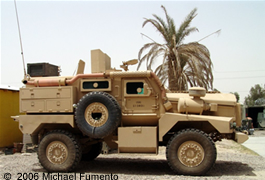
The lightly-armed but heavily armored Cougar. It has a sloping plate on the bottom to difuse the force of an IED blast – though some have still been destroyed.
Another indicator of progress is the expanded areas of operation for the primary unit at Corregidor – 1st Battalion, 506th Infantry Regiment, 101st Airborne Division, and its support elements. The battalion’s predecessor primarily patrolled two areas, the Mulaab and the Industrial Area that includes OP Hotel – an observation post in a former hotel. These two kept the unit so busy that they rarely went into their other areas, Sufia and Julaybah. But now 1/506th regularly patrols all these areas in addition to manning Entry Control Point 8, which straddles the Industrial Area, Sufia, and Julaybah. The enemy struggled mightily to destroy ECP-8 while it was under construction but failed.
Corregidor, still perhaps the nastiest place I’ve stayed in the course of three Anbar embeds, was nonetheless like coming home. I was back in a tiny crackerbox of a room that I had to share with a military photojournalist visiting from Baghdad, with about four square inches of open floor space once I’d dropped my equipment. Body armor is still required outdoors throughout the camp, although mortar attacks have lessened. And we still had a sandbagged roof that would probably stop a 60 millimeter mortar, but wouldn’t have a chance against an 81 or 122. There have been some slight improvements. There is a Post Exchange now, though it seems to sell only about 15 items. There is also a "Hajji-mart," as it is informally called because Iraqis operate it. It sells considerably more items that make the GIs’ lives easier.
Patrols from Corregidor still wreak havoc on embedded reporters. Last time I arrived just after photographer Toby Morris had been shot twice in the leg by a sniper, snapping the bones in two places. This time, the previous embed, cameraman Joe Talley, had caught a sniper round in the ribcage that tumbled and popped out his chest. But both had risked their lives for noncombat photos and footage (a portrait in Morris’s case) when they knew the enemy was actively operating in the area. Ramadi is intolerant of such mistakes.
The men at Corregidor seemed genuinely glad to see me. The vast majority of them would never tell their own families their story. But they were glad someone else did. A few asked in a friendly manner, "Why the hell did you come back here?" I replied, "Still figuring that one out."
Practically the first person I ran into was the commander of Corregidor and the 1/506th, Lt. Col. Ronald Clark. That’s because he’s one of those people who seem to be everywhere at once. Outwardly, he is the antithesis of the man you’d expect to find leading a unit of elite warriors. He says grace before meals and always has a smile on his face. When I ran into him and we sat down in the chow hall, SSgt. Ken Cooke, head of Corregidor’s sniper section, leaned down and gave him a big bear hug. (Indeed, Cooke is about the size of a bear, albeit without any pre-hibernation fat.) "Can you imagine that?" said a bemused Clark. "Head of the sniper team, 120 kills. And he just comes up to you and gives you a big hug!"
Actually, snipers need hugs, as they are the primary targets for other snipers. But here’s what’s remarkable. During its deployment, Cooke’s handful of snipers (the exact number is under wraps) with those 120 kills have accounted for about a fifth of the total known kills of the 1/506th. Meanwhile enemy snipers, though generally the most skilled of the enemy fighters and armed primarily with good 7.62 millimeter Soviet Dragunov sniper rifles, have killed 1 member of the battalion. The battalion plus its support units have lost a total of 8 men while killing about 600 – a stunning ratio of 75:1. Think about that the next time you hear of the prowess of the enemy.
Casualties of War
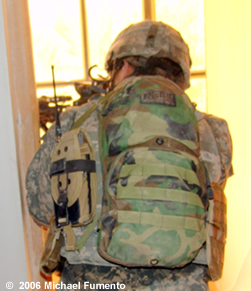
A soldier from A Company, 1/506th keeps himself protected in a doorway while killing an insurgent with his M-203 grenade launcher.
Nobody was killed operating out of Corregidor while I was there, but three days before my arrival, the 19-man SEAL platoon I had photographed and videotaped in combat earlier this year lost its second member, Navy Petty Officer 2nd Class Michael Monsoor. He threw himself on a hand grenade to save three of his buddies. He was the second SEAL killed in Ramadi and second killed in Iraq. The first, Petty Officer 2nd Class Marc Allan Lee, was lost in August. Anyone who harbors the notion that SEALs are as tough on the inside as they are on the outside is wrong.
After I wrote an obit on Lee for my blog, many who knew him opened up their hearts to me. When I blogged on the death of Monsoor from Ramadi, I got the same reaction.
 View video: The failed suicide attack on OP Hotel in 2005. (.wmv, 40 MB)
View video: The failed suicide attack on OP Hotel in 2005. (.wmv, 40 MB)
One of Monsoor’s buddies emailed: "When you did your patrol with SEAL Team 3 a few months back, I was really pleased to see some of the great pictures and accounts," he wrote. "I even put one of your pictures . . . on my Blackberry to have a constant reminder about my comrades in combat. [When] I attended the memorial service for Michael Monsoor . . . his platoon put together a photo/video tribute to him, and right in the middle of it flashed your photo of Mike with his machine gun kneeling beside [a] wall." He continued, "I pulled my Blackberry out of my belt and showed it to my buddies sitting with me and they were astonished. That photo had really been an inspiration before Mike gave his life, but it means so much more now. Good on ya for making those embed trips to Ramadi; I’ll probably be heading over sometime next year myself."
Now I knew why I’d come back.
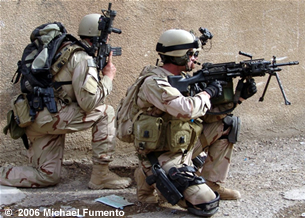
Michael A. Monsoor, Navy SEAL, Killed in Action, Sept. 29, 2006
Even by the standards of the world’s most celebrated special ops unit, Michael Monsoor exemplified "above and beyond the call of duty." I shared a rooftop with him and other members of SEAL Team 3 in the vicious Mulaab area of Ramadi during a firefight last April 22. The photo here, with Monsoor on the right, was taken on the street shortly after the first shots rang out. Weeks later, Petty Officer Second Class Monsoor and another SEAL brought to safety a team member even as bullets ricocheted around them – an act of heroism for which he would be awarded the Silver Star.
On September 29, he performed his greatest – and last – service. While in a sniper hideout with three other SEALs, the 25-year-old machine gunner was closest to an opening in the top. Their position was discovered and clearly something bad would happen unless they were extracted first. It happened. A hand grenade flew through the opening and bounced off Monsoor’s chest. He could have tried throwing it back, though by now it was surely near exploding. He could have dived away, saving his own life but forfeiting that of the others. Instead Monsoor smothered the explosive with his own body. "He never took his eye of the grenade; his only movement was down toward it," a lieutenant who was there said. "He undoubtedly saved mine and the other SEALs’ lives, and we owe him." We all do.
Delta Company of 1/506th took it on the chin while I was there. One night a D
Company soldier got out of his Humvee to fix concertina wire that looked like it had accidentally been separated. But it was no accident. He stepped on a pressure-plate IED. Initial reports said he’d lose the foot, but later ones indicated he had movement in it and might keep it. In another incident, far more bizarre, somebody tossed a hand grenade from inside or on top of a house right down the open turret of a D Company Humvee. Amazingly it landed between the radio and another metal box, which dissipated the force of the explosion. Although all three occupants caught shrapnel, two were hospitalized with only minor wounds. The third caught it bad enough that it wasn’t clear whether he would keep his leg. He also lost a pinkie finger.
A night or two later, members of the 1st Battalion, 6th Marine Regiment, which runs patrols out of Camp Ramadi, were traveling in a Humvee when a massive IED hit it. Then the enemy zapped the hulk with an RPG for good measure. The initial word was two Marines killed in action and one missing. Missing. The mere utterance takes your breath away.
No fate in Iraq is more terrifying than being captured by the anti-Iraqi forces, who readily invoke the Geneva Convention for their own men taken prisoner but have never heard of it when it comes to those they grab. In fact, the third Marine had been killed. The force of the blast was so great that it took a while to find what was left of him.
** "Bag ’em, tag ’em, and drag ’em" **
Asked if I wanted to go on a night operation with A Company, I said I wanted to go on all patrols; but I wasn’t looking forward to it since the enemy virtually never attacks night patrols and my last night mission out of Corregidor captured nothing more than a bag of old AK-47 rounds.
I was told this time we had targeted nine individuals in what Ron Clark called a "Bag ’em, tag ’em, and drag ’em" operation. I groused that we wouldn’t grab a single one. Wrong.
In terms of materiel, the squad I accompanied captured nothing more than one toy gun, one rifle with a huge bayonet and a stock that had decayed to nothing that probably was last fired in the 19th century, and an AK. Each house is allowed one AK for self-defense, so we gave all the "weapons" back.
But at a neighboring house, five of the nine suspects were nabbed, interrogated on the spot, and one was kept. Meanwhile, three other men were grabbed and upon interrogation appeared to be "dirty," as the GIs put it. So in all, four men were taken into custody.
Quite an improvement over a bag of bullets.
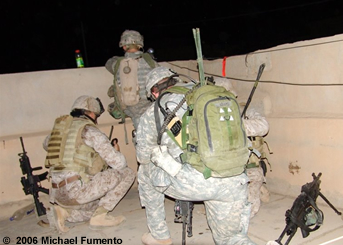
Soldiers from A Company, 1/506th establish security on a rooftop while the house below and those around it are searched for enemy and weapons.
When combined with the results of a night raid I would make a few nights later with another unit, this seems to indicate that despite desperate efforts by the anti-Iraqi forces to keep citizens of Ramadi from providing valuable tips – efforts including murder, torture, and destroying phone lines and cell phone towers – the enemy is indeed wearing out its welcome in a city it once essentially owned. The 1/506th wasn’t making day patrols, it turned out, as a show of respect for the observance of Ramadan. The closest I got was a mounted excursion into the Mulaab to guard a psy-ops truck with a loudspeaker recruiting for the Iraqi police.
Charlie Company commander Capt. Nathan Guthrie, whom I sat behind in the Humvee, wasn’t the shy, retiring type. He barked orders and opinions on about an equal basis. Before we left he told the machine gunner, "When we’re going down Easy Street, if you see that sniper you smoke his f--ing ass! I’m not dealing with his ass anymore." I was confused. "If you know where a sniper is, you always ’smoke his ass’ don’t you?" Guthrie explained: "It’s like the D.C. area snipers," meaning the October 2002 killings carried out using a hole cut in a car trunk, the perpetrators of which proved hard to catch. In August, the U.S. forces seized two Iraqi snipers who’d been using such a vehicle. They made the rather dubious claim to have shot 31 Americans in this way. "This place [the Mulaab] has gotten a lot better but it’s still a s--t hole," Guthrie commented.
 View video: A Navy FA/28 airstrike at ECP-8. (.wmv, 40 MB) (Courtesy of Sgt.
Steve Campbell, A Company, 1/506th)
View video: A Navy FA/28 airstrike at ECP-8. (.wmv, 40 MB) (Courtesy of Sgt.
Steve Campbell, A Company, 1/506th)
Guthrie kept uttering things that anywhere else would have made him a certified paranoid, but not here. We saw two men on a moped carrying a shovel. There are many uses for a shovel, but my first thought was they were off to bury IEDs. Sure enough, Guthrie commented, "They’re probably going to bury IEDs." We also saw an empty dump truck twice. If it’s not visibly hauling something, it’s suspect. If it has special windows over the regular ones, it’s clearly a suicide vehicle-borne IED. "If that dump truck turns down this way and has welded plates on the window, you shoot that motherf--er, you hear me!" Guthrie barked to his gunner. But no motherf--ers died that day; at least not there.
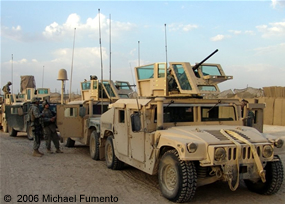
C Company, 1/506th, heads out to accompany psy-ops trucks on a recruitment drive in the volatile Mulaab area.
We were attacked, making me three for three on daytime operations. And as on the previous occasions, the attack came an amazingly punctual 45 minutes after we took up our position. This punctuality is not evidence of great masterminds; it means they need 45 minutes to organize an attack. Further, this attack comprised nothing more than two guys popping out with AKs and shooting wildly at our Humvee, while we returned fire with the vehicle’s turret-mounted M2 .50 caliber Browning machine gun. Not exactly a fair fight, and the bad guys fled.
Of course, major firefights also begin this way, and Guthrie checked to see if we had close air support available. Since our job wasn’t to engage the enemy but to recruit police, and the psy-ops truck had already made plenty of trips through the neighborhood, we left soon after. Ultimately, the police recruitment campaign brought in about 400 men.
COPs and Criminals
Because 1/506th wasn’t sending out day patrols, I decided to move on to a different unit in a different area operating in a different way. I ended up with the 6th Infantry Regiment, 2nd Brigade, 1st Armored Division.
The term "COP" – Combat Operation Post – first came up during my in-briefing at Camp Ramadi. I didn’t know at the time, and wouldn’t understand until I stayed at one, but COPs may be one of the most important reasons we seem finally to be gaining ground in Ramadi.
There’s no set size for a COP, but in the Ramadi area, it’s an undersized company of four platoons, or about 80 soldiers. 1st BCT has put in 11 COPs so far and is going to install more. The first in Ramadi was created in June. These garrisons are tiny offshoots from much-larger forward operating bases, which in the case of Corregidor has a full battalion plus numerous support elements. That’s about 1,000 men in all. The COP to which I was assigned, COP Anvil in northern Ramadi, comprises just two houses commandeered and leased from Iraqi civilians.

One of the two buildings that make up COP Anvil in northern Ramadi. Note the M-113 armored personnel carrier in front and the barely-visible Mark-19 automatic grenade launcher on the roof.
Anvil is commanded by Capt. Don Sapp of A Company, 1/6. It has an oversized company of more than 120 men from three American platoons and one Iraqi platoon. Anvil also has four M-2 Bradley fighting vehicles attached to it, giving it real firepower. Each Bradley has a 25 mm automatic cannon, a 7.62 mm machine gun, and twin tubes that fire TOW missiles that can destroy a tank at almost two and a half miles. Anvil draws support from Forward Operating Base Blue Diamond, which in turn draws support from Camp Ramadi.
Historically, successful counterinsurgency efforts have involved pacifying areas by plopping small garrisons with interlocking communications into enemy territory and sending out patrols to gather information and engage the enemy. Perhaps the most famous example of such garrison use was that of King Edward I of England (yes, the guy who had Braveheart drawn and quartered), who used castles to consolidate his hold on a conquered but restive Wales. More recently U.S. Army Special Forces established Civilian Irregular Defense Group camps in South Vietnam, manned primarily by indigenous tribes or South Vietnamese with a core of Special Forces soldiers. Such camps are considered one of the most effective strategies of that war. Certainly they were far more useful than the "search and destroy" missions sent out from huge base camps.
The military refers to COP use as "the inkblot strategy." One dot spreads into a bigger spot. Further, the troops are practically forced to work with the locals. That means building up networks of indigenous people who know the terrain, culture, and other people better than any forces – even one from the same country but another province – ever could. This also allows for more direct contact between the leader of the military force and the local leadership. All of this creates a force multiplier. Since the Bush administration appears unlikely to increase troop strength significantly, this ability to make better use of troops without weakening the forward operating bases from which they’re drawn is vital.
Another value of the Ramadi COPs over the FOBs and Camp Ramadi is that we’re fighting an enemy that relies primarily on roadway bombs – whether IEDS, vehicle-borne IEDs, or suicide-vehicle borne IEDs (driven vehicles) – to inflict casualties and damage, with the potential for greatly restricting movement. But missions from COPs are inherently short-range; you’re always almost there. That’s less road to be on and hence fewer explosives and ambushes to worry about. Even COPs operating at half strength have no chance of being overrun both because of the inability of the enemy to fight skillfully or mass in large numbers and because of the multilayered defenses.
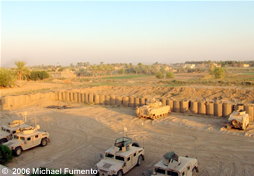
View from Anvil showing its excellent clear-kill zones. The short-looking tubes are HESCO baskets connected to form an impregnable wall.
Anvil has concertina barbed wire and HESCO baskets as an inner layer of protection. A HESCO (named for the British company that invented it) is a huge thick bag in a wire mesh into which sand or dirt can be dumped. Linked together, the bags form an extremely effective blast wall and an impregnable barrier. Sapp took advantage of Anvil’s rural location to cut down vegetation surrounding his two buildings, creating a nice clear-kill zone. Ingress over irrigation canals is controlled with concertina wire in some of the canals and by knocking down numerous foot bridges and replacing them with three steel Bailey bridges that can be readily watched.
Two men are always on top of the American-occupied building (the Iraqi army controls the other structure) to survey the countryside, which the clear-kill zones make easy. In addition to their personal weapons, they have access to an anti-armor rocket, a Mark-19 40 mm automatic grenade launcher that fires at an amazing rate of 350 rounds a minute out to a range of 2,200 meters, and a .50 caliber M8A1A sniper rifle that can take out targets at a range of 1,800 meters. One .50 caliber shot into an engine block can stop a vehicle in its tracks. (You don’t want to hear what it can do to a human being.) While we were in the building talking, Sapp and I heard a 7.62 rifle round go off. One of the observers had seen a man digging near a road and fired a warning shot at him. In the central area of the city, the man would have been dropped. But in rural areas, you expect people to dig with shovels; you just can’t let them do it too close to byways.
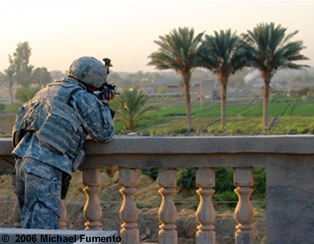
An observer atop COP Anvil takes aim.
Sapp showed me the impact of the Combat Operation Post system in Ramadi
(Fallujah also has some) on a map. The foreign fighters who come into this area do so along the main highway from the Syrian border to the west. It’s a mini-Ho Chi Minh Trail, so to speak. From this road the terrorists used to fan out in the area where the COPs have been inserted. "In the last four months, we’ve kept pushing them right around here," Sapp indicated, with his finger moving in a counter-clockwise pattern. "Initially we wouldn’t go anywhere in this area with anything less than a platoon and sometimes even armor," he said. "But now I allow them to enter with just squads." The only part of the fan still remaining abuts the Euphrates. "We give the terrorists a place to focus here," Sapp says of that last slice. "This gives them somewhere to go and I’d rather they go there where my men can deal with them than have them setting up IEDs thickly throughout the area they used to control."
At Anvil almost all missions are on foot and off the trails. That’s part of the beauty of the COP system; you can go almost anywhere you need to on foot without alerting enemy sentinels – which are probably nothing more than some guy paid a few bucks a night to keep watch. The night I was there we set off to grab some of bin Laden’s buddies.
A Wet but Successful Night Raid
Terror suspects fall into two categories: single source and double source. That indicates whether they were identified by one informer or two. The idea behind the distinction is that any vindictive neighbor can accuse somebody of something he didn’t do. But with two sources, there’s a higher probability the accused really is "dirty." Mind you, Sapp told me, "Ninety percent of the time a single source suspect is also a bad guy." But those are the rules. A double source suspect goes straight to military intelligence. A single source suspect must be released within 72 hours unless he confesses, but at the very least his vitals go into the data bank in case he’s later identified as dirty.
Such raids used to be directed solely against the house where the suspect normally lived. But Iraqis are generally quite chummy with their neighbors, who often are also relatives. It’s something of a "Mi casa es su casa" arrangement. They keep vast numbers of cushioned rugs piled up that can be used as beds when friends or relatives come calling. Suddenly a house built for five people can hold 25. What this means for nabbing bad guys is that you don’t want to just hit the house that’s his main domicile but also those next to it.
In this case, the houses are about 400 meters away from the COP, and the best avenue of approach would be through a series of irrigation canals and the offshoot ditches. This canal system would prove my undoing. Jumping from little strips of land to other little strips is an acquired skill.
I was offered night vision equipment, but it was the kind that attaches to your helmet, making you look like a Borg from Star Trek. My helmet wasn’t made for it, and in any case I’d never trained with the things, so I relied on my own night vision. As we hopped over the rivulets and water-filled trenches, I slipped twice on the slick dust, negotiated a number of obstacles, and then came to a canal. Too dark to see how wide. The soldier in front of me tossed his pack across and leaped. I tried as hard as I could but fell short. "Oof! Ugh! Yech!" Right up to my ribs. It could have been worse; it could have been an open sewer. But my still camera was knocked out temporarily and my video camera and voice recorder were ruined. And I was covered with mud, while Anvil was the only place I’ve embedded that didn’t have even a cold shower. I did feel a bit better when I discovered the next day that three of the soldiers had also fallen in. It was interesting going out in the sunlight afterwards and seeing how treacherous the terrain really was. "I hate that night s--t," a soldier told me.
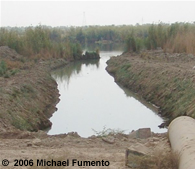
An irrigation canal in northern Ramadi: These are not pleasant to fall into.
The raid couldn’t have gone better – not that I had the ability to get any images or sound. We hit one house, and before anybody in the second house knew about it we hit that one too. We struck the jackpot in the form of an al Qaeda intelligence officer whose chief job was assassinating Iraqi police. He was perhaps 22 years old. As soon as the plastic cuffs were on him he faked heart problems and then breathing problems. I guess he thought the soft-hearted Amerikani would just let him go. Tough luck.
This man had been double-sourced. We also grabbed a single-source suspect and a very young man who was with the first two. Both admitted the next day to being al Qaeda fighters. We brought them back and put them in an outdoor holding pen. Three terrorists in one night is a nice haul.
Sapp said the Iraqi Army complain about taking as prisoners suspects who are almost certainly dirty. They say that all too soon they’ll be back and shooting at them and they have a point. The suspects really do get hearings, and if they’re in Sunni areas those judges are Sunni. Some were probably appointed by Saddam. Still, it’s better to capture these men than to kill them. One corpse means eliminating one man, but a suspect who talks can lead to anything from rolling up a cell of three or more men to capturing or killing terrorist leaders like al Zarqawi. This isn’t the "kinder, gentler war" of which I’ve heard American soldiers and Marines complain; this is how you stomp out guerrillas and make a place too hot for foreign terrorists.
We heard five IEDs explode that night – all controlled detonations. So the next day we went out on what’s called a "meet and greet" patrol, partly just to show our presence and partly to collect information from willing locals about the IEDs. Unfortunately, they’re rarely willing to talk. They’ll even deny hearing IED explosions that occurred outside their bedroom windows. Some are afraid of being seen as coalition suspects; others may be afraid of retaliation, and some are taking money from the bad guys. As I took pictures of a large family we interrogated on the road, our Iraqi translator said I was probably photographing IED trigger men. "They are poor," he said. "And they are offered money just to push a trigger." By Iraqi standards they didn’t seem poor at all. I saw well-fed cows, goats, and sheep everywhere. Corn was already growing, if not as high as an elephant’s eye, and other crops will start springing up when the rainy season begins shortly.
Are We Winning?

"They are offered money just to push a trigger."
People always ask how the Iraqis feel about Americans and the war in general. I respond that they just tell you what they think will prove advantageous to them, a combination of complaints and praise for Ameriki (America). Non-embedded American reporters run into the same thing. I asked one of the north Ramadi farmers through the translator if he thinks Ramadi is getting safer. He starts out with a few complaints, such as lack of water from the Euphrates for his fields because of rationing, and then tells me: "But safety is 100 percent better now that the Americans have come along." Baloney. Things got a lot more dangerous when we first came along. They may or may not be safer now than a year ago, but this guy isn’t going to tell me. None of them will tell me.
Soldiers also give different accounts of the extent of progress in Ramadi. A Cougar driver told me nothing had changed since his last deployment, yet the very fact that he was driving into Ramadi in a convoy of just four trucks indicated otherwise. Another told me Ramadi is now "a thousand times better." Ultimately each was simply another blind man feeling his part of the elephant. With my three embeds in Anbar, I’d like to believe I’ve felt quite a few parts of the elephant.
Ramadi is not Baghdad, with its roiling sectarian violence and militias. As we’ve come to learn, Iraq probably cannot find peace until those militias are disbanded and suppressed. But neither will it find peace if the insurgents and terrorists of the Sunni strongholds like Ramadi continue to ply their trade; and despite the media focus on sectarian killings in October, Sunni insurgents still accounted for more than 80 percent of American military deaths in Iraq that month.
Put it all together – the Forward Observation Bases, new Combat Operation Posts, new Observation Posts, tribal cooperation, ever more Iraqi army and police, better intelligence, and public works projects. There’s no "stay the course" strategy here; the course changes as necessary and it’s continually changed for the better. I believe we are winning the Battle of Ramadi. And if the enemy can be beaten here, he can be beaten anywhere.
